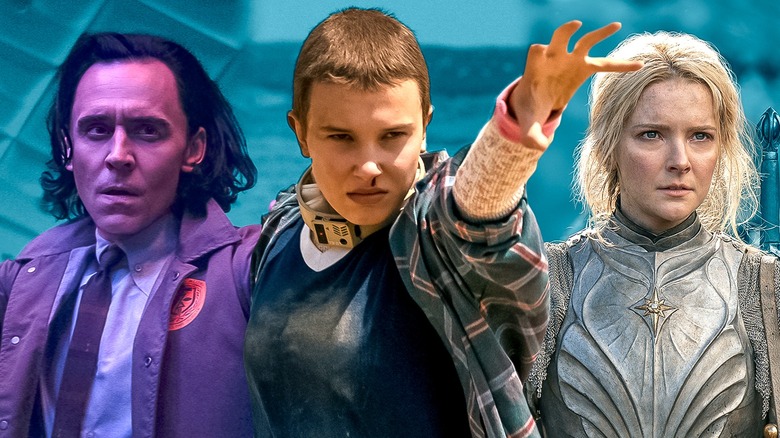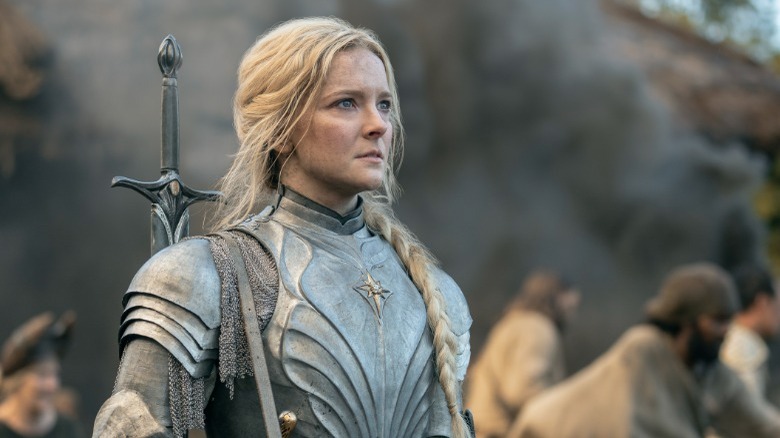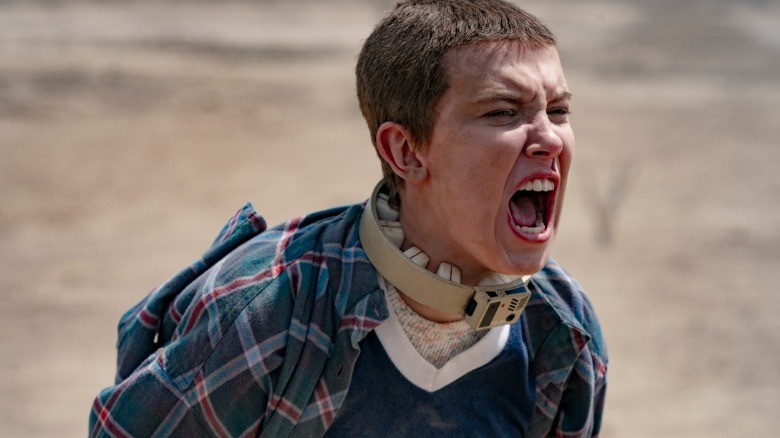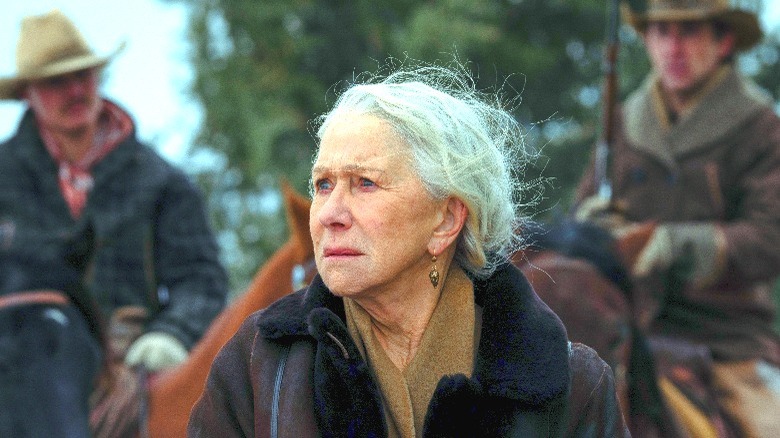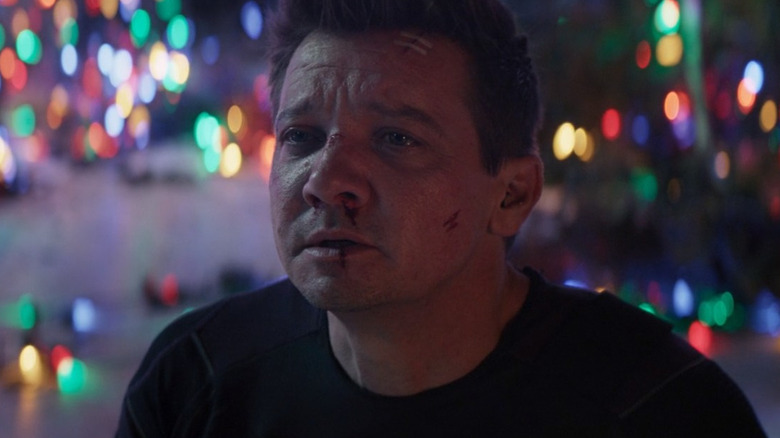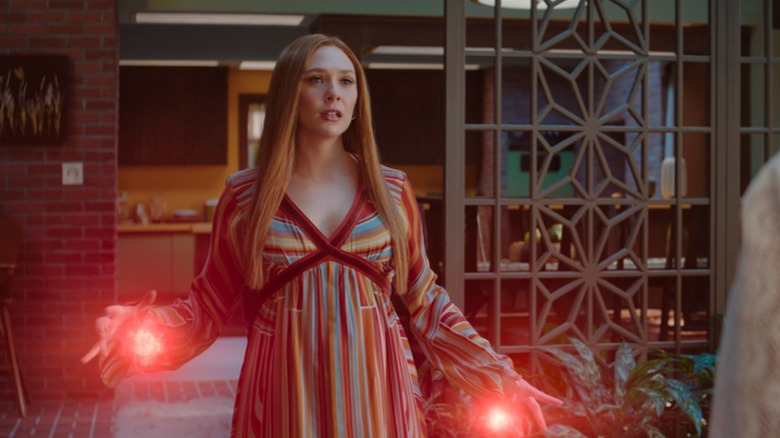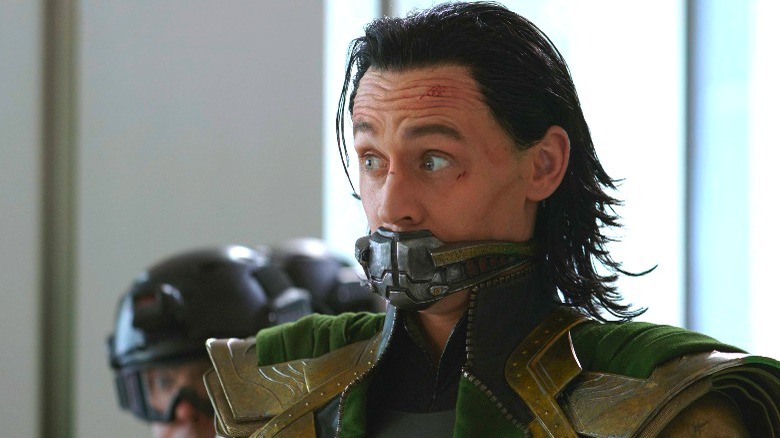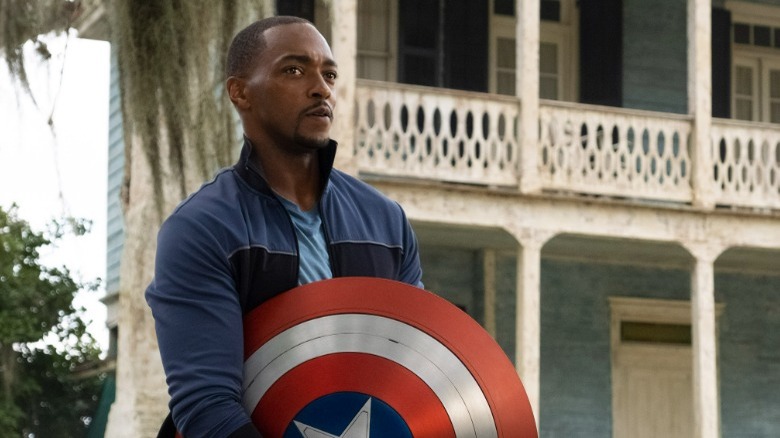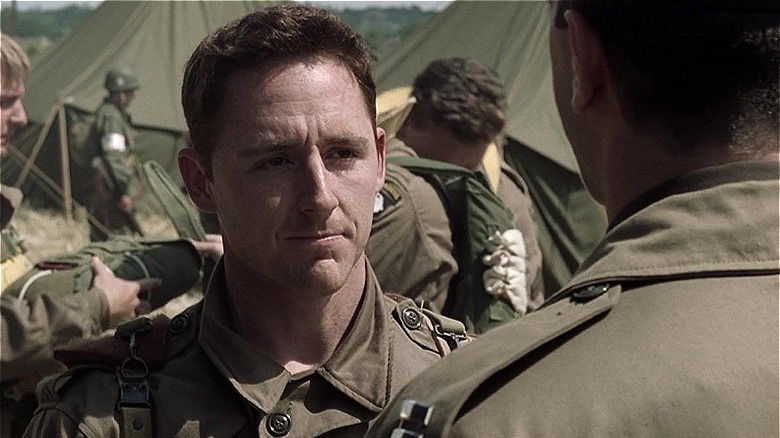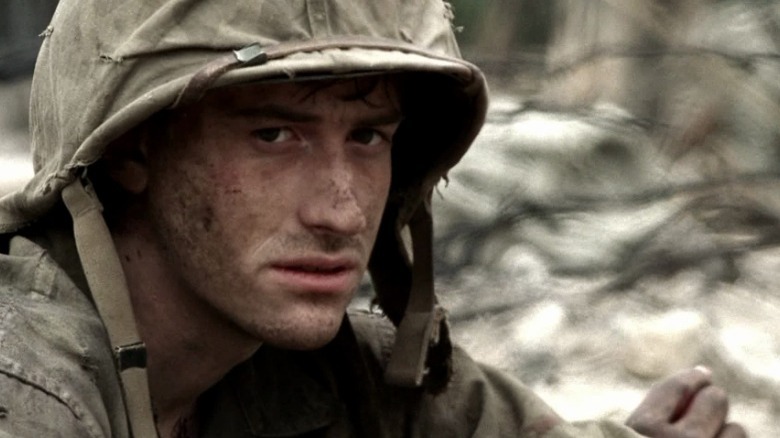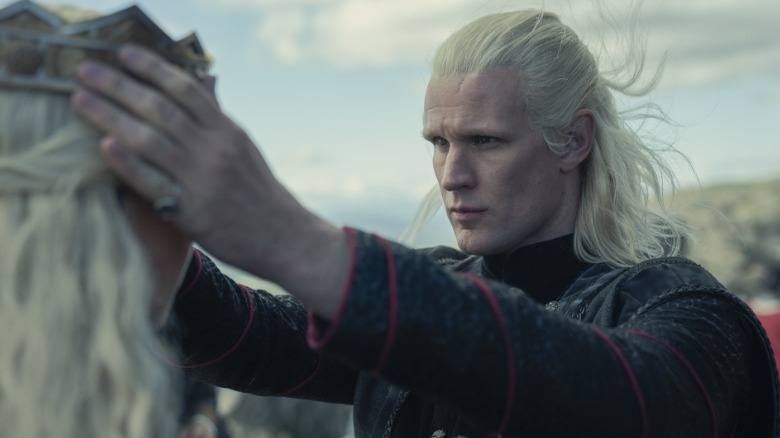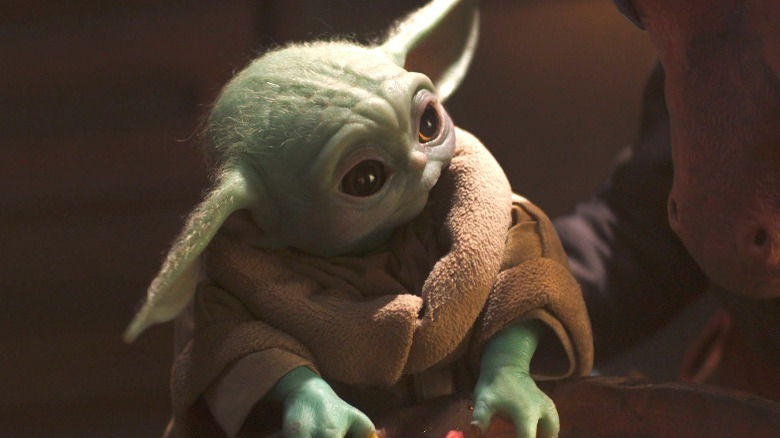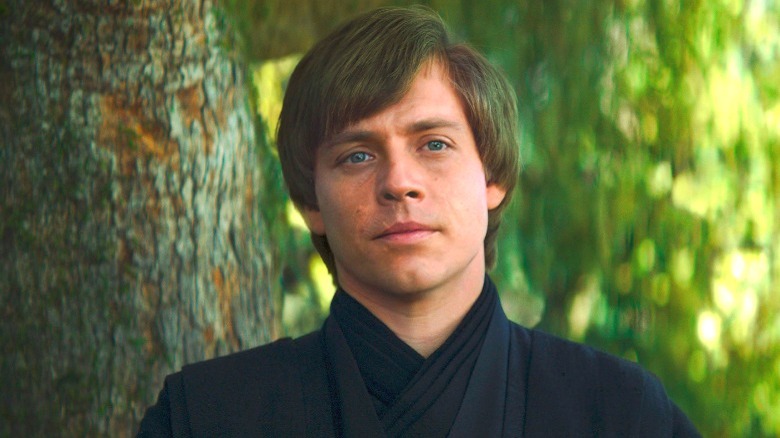12 Most Expensive TV Show Productions Of All Time
There once was a time when television was considered far less prestigious than box office productions. But after groundbreaking TV shows like "The Sopranos" and "Lost" began to prove television was just as capable of producing compelling, epic storytelling, a sea change took place. From directors like M. Night Shyamalan and Guillermo del Toro to big-name actors like Julia Roberts, Harrison Ford, and Sylvester Stallone, many talented stars are shifting from the silver screen to the small screen. As the race to produce quality content heats up, so do the budget sheets for these shows.
From the opulent costumes of "Bridgerton" to the dazzling augmented reality (AR) wall used in "Star Trek: Discovery," those outsized budgets add up to pretty fantastic television. If you love a good TV binge as much as we do, hang onto your remote while we break down the most expensive TV productions of all time and the big-ticket items that give them their extravagant price tags.
The Lord of the Rings: The Rings of Power
Taking the grand prize for the most expensive television production to date is "The Lord of the Rings: The Rings of Power," coming in at a whopping $58 million per episode. An epic high fantasy series, the J. R. R. Tolkien adaptation is set millennia before the events of "The Hobbit" and "The Lord of the Rings" — a time that would have gone down in mythology by the time Frodo made his hero's journey were it not for the long lifespans of the elves. When the Tolkien series was first made available for adaptation, a bidding war erupted between major streamers HBO, Amazon, and Netflix with Amazon coming in the winner at a hefty price tag of $250 million.
In a world of AR walls and green screens, "The Rings of Power" stands out for its elaborate on-location sets, which production designer Ramsey Avery says are meant to capture the golden age of Middle-Earth before Sauron's villainous shenanigans start to drag everything down. Factor in the elaborate costumes and full-scale ensemble cast size, and it's a recipe for the most pricey series ever made. With a grand total of five seasons ordered and already planned in their entirety, the total budget could come in at more than a billion. As Amazon Executive Chairman Jeff Bezos is reputedly a huge Tolkien fan, we know at least one person who will be watching all the way through to the end.
Stranger Things
In a time when Netflix has been tightening its purse strings and enigmatically cutting solid performers like "1899," one show they've funneled more money into is the hit supernatural sci-fi series "Stranger Things." Since the show's $6 million per episode freshman season, the series has gradually increased its budget while continuing to ramp up the killer computer-generated and practical effects. By 2018, several of the show's cast were taking home paychecks of around $250K – $350K per episode, and it's estimated that by the show's end, the total price tag for the season came in around $270 million. According to Netflix executive Ted Sarandos, a hefty chunk of the Season 4 spending increase can be attributed to covid, which hit the budget hard between the need for extra protocols and shutdowns.
As anyone who has seen the show's fourth season can attest, the bloated budget was money well-spent. The show boasts some of the most beautiful CGI ever to grace the small screen and is a testament to the truly cinematic quality a well-executed streaming series can have. The attention to detail when it comes to practical effects — especially those used to pull off the Season 4 villain Vecna — earned the series the Emmy for best prosthetic makeup in 2022.
1923
The second prequel to Taylor Sheridan's hit series "Yellowstone" after the Oregon Trail-set "1883," "1923" follows the Dutton family's next generation through their trials and tribulations during the rapidly changing years leading up to the Great Depression. Speaking to Deadline, Sheridan mused, "I don't know what the Game of Thrones budgets were, but I don't know how they could have been more than this," comparing the series to "Lawrence of Arabia" in terms of its epic scale and feel.
One of the show's big-ticket items is its two lead actors — with the ensemble cast including Hollywood legends Helen Mirren and Harrison Ford — whom Sheridan refers to as the show's anchors. But this is just the beginning. To create the sense of life on a Montana ranch, the series uses thousands of real cattle and sheep. Besides its principal photography in the same Montana locations as "Yellowstone," some of the show's scenes were filmed in Malta, Tanzania, Kenya, and South Africa as the series recounts a prodigal Dutton's epic journey home involving — among other things — a safari and an ocean adventure. Filming during the pandemic meant covid protocols upped the costs even more. There are also the added costs of transforming the sets into a world that took place 100 years in the past. The grand total for this gorgeously rendered historical drama comes in at around $30 million per episode, making it one of the highest-ranking series ever made in terms of cost.
Hawkeye
A limited series meant to fit into Disney's Marvel canon, "Hawkeye" racked up a $150 million price tag during its six-episode run — that's about $25 million per episode. Like all the Marvel Television miniseries, the film's big budget is part of Disney CEO Bob Iger's commitment to streaming. For the sake of comparison, the box office hit movie "Captain Marvel" boasted a budget of around $152 million, according to Deadline. As with many of the higher-budget series, one of the show's major costs is its star power. Jeremy Renner, who reprises his role as the titular character in the series, is one of the higher-paid actors in the Marvel universe.
While his salary for the series isn't widely known, Parade reported that the actor made $15 million for "Avengers: Endgame" and likely took home a comparable paycheck for the limited series. As the series was primarily filmed in New York City, Georgia, and Ontario, they weren't dropping their budget on hauling an entire cast and crew from one exotic location to the next. Like every other installment in the Marvel Cinematic Universe and Marvel television canon, the production required a budget-taxing CGI effort. Judging by the controversy stemming from the disappointing graphics in Episode 3 and complaints about pay and working conditions from Marvel VFX teams, this is one area that the franchise shouldn't be cutting costs in.
WandaVision
The first series after Marvel's transition to Disney's Marvel Studios in Phase Four of the MCU, "WandaVision" was a much-hyped and well-received entry into the Marvel canon. Like the source material that the Marvel stories are drawn from, the MCU keeps the superhero genre fresh by serving up a variety of tones and storytelling styles, and "WandaVision" is a stunning example of this. Starring Elizabeth Olsen as Wanda Maximoff and Paul Bettany as Vision, the series finds the pair trapped in a strange alternate reality that looks and feels like a laugh-track sitcom. As the episodes progress, the pair transitions from one decade to the next, traveling through sets inspired by shows like "I Love Lucy," "Bewitched," and "The Brady Bunch," each plagued with surreal glitches that hint there's something nefarious going on under the surface.
Like other Marvel Television series, "WandaVision" was granted a generous budget of about $25 million per episode, and it shows. Besides the lead duo's earnings and the production's beautifully crafted sitcom set designs and S.W.O.R.D. base, the show featured 400 shots of applause-worthy VFX created by a team of 100 or so compositors. The 40-second shot of Vision flying around Westview alone took months to produce. According to Ryan Freer of MARZ VFX, the aerial view of Westview during that scene was painstakingly rendered CGI (per Insider).
Loki
The third series in Disney's Marvel Studios collection, "Loki" is a time-travel adventure that finds an alternate version of The God of Mischief forced by the timeline-policing Time Variance Authority (TVA) to repair the damage to the timeline when he swiped the Tesseract during "Avengers: Endgame." Called "a nexus of two Terry Gilliam movies" by SFGate, the wickedly fun time travel twister is one of the best offerings from Marvel Studios. And with a budget of about $25 million per episode, it's one of the best reasons to add Disney+ to your favorite streamers.
Besides being the funniest series in the MCU collection, "Loki" is also one of the few Disney Marvel shows to go beyond one season. Filmed in the distinctive Atlanta Marriott Marquis — which also served at the Tribute Center in "The Hunger Games" franchise — the series stars Tom Hiddleston as the MCU's favorite trickster. Judging by the reported $8 million Hiddleston was paid for his role in "Avengers: Infinity War," a decent chunk of the show's budget goes toward his paycheck. Many fans and critics agreed that the series felt more like a film than a TV show, and its first season was nominated for six Emmys including one for costumes and another for outstanding production design.
The Falcon and the Winter Soldier
Another one of Marvel Studios' more expensive projects, "The Falcon and the Winter Soldier" boasts a comparable budget to "WandaVision" and "Loki" at around $25 million per episode. The series takes place a few months after Sam Wilson takes over as Captain America from Steve Rogers in "Avengers: Endgame." The series stars Anthony Mackie and Sebastian Stan — reprising their roles from the films — as the titular duo, and with actors like Don Cheadle, Emily VanCamp, Julia Louis-Dreyfus, and Wyatt Russell on board, the series doesn't skimp on casting. A six-episode limited series, "The Falcon and the Winter Soldier" was partly filmed in the Czech Republic, adding to the overall cost. The covid outbreak of 2020 completely halted production for several months, with additional protocols only serving to further jack up the show's overall price tag.
While some critics felt the show's early pacing could have been better, overall, it drew praise for its social commentary and the chemistry between its leading actors. The show's big budget is well-spent, making it an enjoyable series overall even if it isn't the strongest limited series in the Disney Marvel Studios collection.
Band of Brothers
These days, a blockbuster movie budget is hardly a rarity in the world of TV production. But when "Band of Brothers" came out, there had really never been anything quite like it to date. Produced by Steven Spielberg and Tom Hanks, at the time of its release the ten-episode miniseries was the most expensive television production with a budget of $125 million — which would be closer to $200 million today. Similar in scope and content to "Saving Private Ryan," "Band of Brothers" follows Easy Company, a group of World War II paratroopers from the 506th Parachute Infantry Regiment of the 101st Airborne Division, from training through their deployment on D-Day and ultimately through V-J Day.
A large part of the budget went to support the massive ensemble cast, many of whom were relatively unknown at the time of filming but have gone on to become famous faces today. In the interest of depicting the war as accurately as possible, the filmmakers and cast consulted many of the still-surviving Easy Company veterans, invested in authentic uniforms and equipment, and poured plenty of cash into realistic pyrotechnics. The effort paid off, with many World War II veterans and history experts alike agreeing that the series presented one of the most accurate portrayals of World War film ever produced. After the production ended, they had one more investment to make: flying 47 surviving Easy Company vets to Paris for a special screening.
The Pacific
Produced by Tom Hanks, Gary Goetzman, and Steven Spielberg, "The Pacific" is a 2010 production that serves as a companion piece to "Band of Brothers" set in the Pacific theater. Much like "Band of Brothers," it would become the most costly television series ever produced at the time of its release for many of the same reasons. As production began, the budget for the limited series was originally set at $120 million, but by the time the show aired, HBO had spent around $217 million on it.
According to co-executive producer Tony To, the commitment to realistically filming battle scenes was tremendous (via Reuters). Take the landing at Peleliu, which took four days to film and came in under budget at around $5 million. The scene featured upwards of 300 actors, each of whom was clad in perfectly duplicated 1940s military uniforms, faithfully replicated on period looms. On top of the costs of working with a large cast, producers had to factor in pricey practical effects, props, and pyrotechnics, with production costs coming in at around $270,000 per filming day. Fortunately, producers were able to cash in on some serious rebates by filming in Australia, slashing the cost by about $20 million from what it could have been, and some of the processes had become streamlined in the decade following "Band of Brothers" thanks to advances in technology.
House of the Dragon
Like "The Lord of the Rings: The Rings of Power," "House of the Dragon" is a prequel fantasy series set before the events of another popular series — in this case, two centuries or so before the events of "Game of Thrones." Like its sister series, "House of the Dragon" features an extra-large ensemble cast of several dozen actors including the incomparable Matt Smith. The first season budget was around $200 million, which comes out to about $20 million per episode when spread across ten episodes. In comparison, the budget for the final season of "Game of Thrones" was around $15 million per episode.
According to a production insider cited in Variety, it was possible for "House of the Dragon" to keep their budget relatively comparable because of HBO's experience with the format — since elaborate production designs feature pretty heavily in some of the network's other shows like "His Dark Materials" and "Westworld." Fans of George R.R. Martin's vision will be glad to know the story is getting the treatment it deserves after cost-cutting led to some not-so-flattering outcomes in Westeros, with Martin specifically noting the budget cuts to a "Game of Thrones" jousting tournament as a point of regret (via The Hollywood Reporter). Judging by the jousting tournament in "House of the Dragon," producers are going out of their way to avoid making the same mistake twice and keep the story creator happy.
The Mandalorian
The first of several live-action "Star Wars" franchise series on Disney+, "The Mandalorian" is a space western set a few years after "Return of the Jedi." Besides the adorable Grogu (aka "Baby Yoda"), the series boasts a fairly well-known cast including Pedro Pascal, Katee Sackhoff, Carl Weathers, Werner Herzog, Nick Nolte, Taika Waititi, Giancarlo Esposito, Jason Sudeikis, and Amy Sedaris, among others.
A few factors accounted for the show's roughly $15 million per episode price tag, not the least of which was its production studio. "The Mandalorian" was the first series to pioneer StageCraft technology, a type of AR wall that allows actors to work against computer-generated backdrops that create the experience of actually being in the story. One of the key benefits of this technology is that it creates more realistic lighting rather than forcing the VFX team to duplicate it when working with a green screen. Besides the show's soundstage, part of the series was also filmed in Death Valley National Park, adding to the production costs. One of the show's more surprising expenses is the cuddly little Grogu. Rather than dump an invariably creepy CGI creature into the series, producers chose to go old-school "Star Wars" with a twist by investing a cool $5 million in the foot-tall robotic puppet.
The Book of Boba Fett
"The Book of Boba Fett" is a Disney+ "Star Wars" series that serves as a spin-off to "The Mandalorian." The story revolves around Boba Fett — the bounty hunter from "The Empire Strikes Back" and "Return of the Jedi" — following the character as he takes over where organized crime boss Jabba the Hutt left off when Leia choked him to death with her chains of enslavement. While the seven-episode series wasn't as well-received as "The Mandalorian," it featured a similar price tag, coming in at around $15 million an episode. The series brought back Pedro Pascal and Amy Sedaris, and like "The Mandalorian," it featured a whole host of other well-known actors including Stephen Root, Timothy Olyphant, Jennifer Beals, Rosario Dawson, Danny Trejo, and a de-aged Mark Hamill. Fans of "Yellowjackets" will also recognize Sophie Thatcher as cyborg leader Drash.
While the series doesn't have a multi-million dollar puppet on deck, it does have its own costly mascot of sorts in the uncannily young Luke Skywalker. Although de-aging technology is improving as it becomes more widely used, it remains a costly investment for any production. Besides smoothing out the effects of time with CGI, the show's many tech experts also used an application called Respeecher to rewind time on Luke's voice, since vocal cords tend to change over time.
